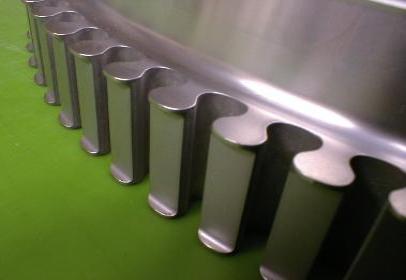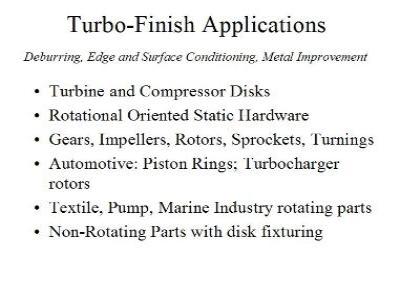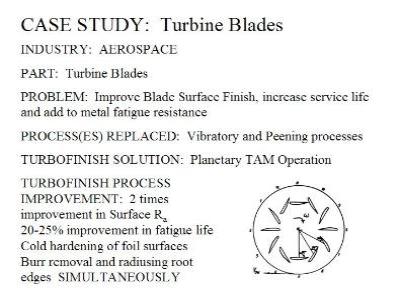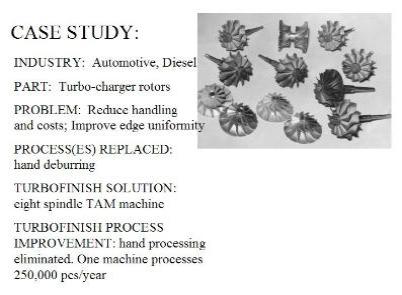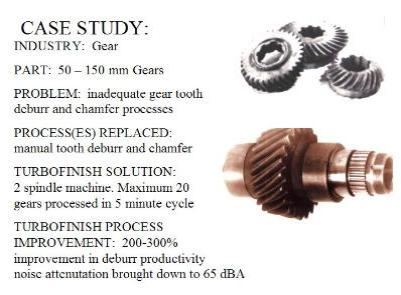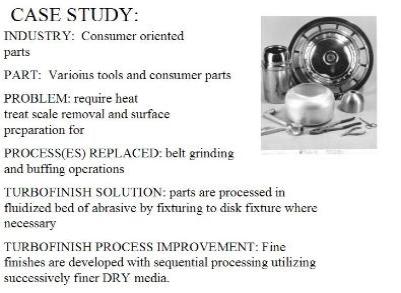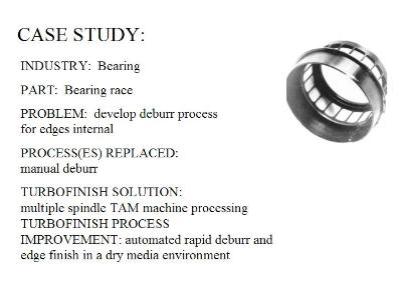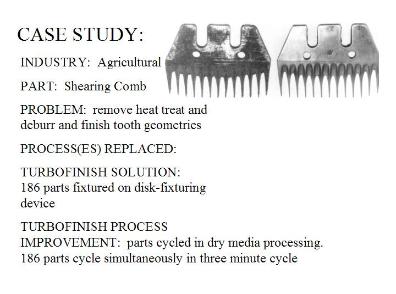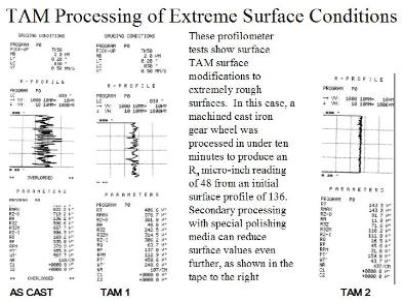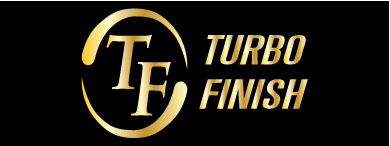
TURBO-ABRASIVE MACHINING
Contact Information:
(T) 917.518.8205
(E) michael@turbofinish.com
(E) info@turbofinish.com
(E) sales@turbofinish.com
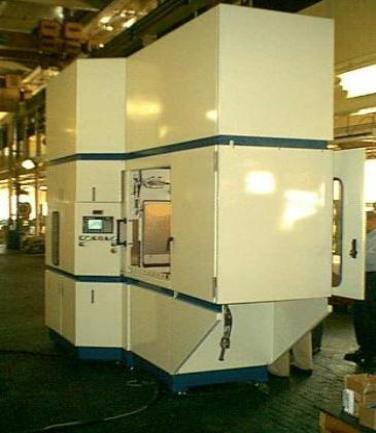
mechanical deburring and finishing method originally developed to automate edge
finishing procedures on complex rotationally oriented and symmetrical aerospace
engine components. Since its inception this method of utilizing fluidized abrasive
materials has facilitated significant reductions in the amount of manual intervention
required to deburr large components. Additionally, the process has also proved to be
useful in edge and surface finishing a wide variety of other non-rotational
components by incorporating these components into fixturing systems. The
advantages of this method go beyond the simple removal or attenuation of burrs.
The method is also capable of producing surface conditions at these critical edge
areas that contribute to increased service life and functionality of parts that are
severely stressed in service. Among these advantages are: (1) the creation of
isotropic surfaces. (2) The replacement of positively skewed surface profiles with
negative or neutral skews and (3) the development of beneficial compressive stress.
Productivity
Deburring and surface conditioning of complex machined parts is one
of the most troublesome problems faced by the metalworking industry.
In many cases parts with complex geometric forms which are
manufactured with very sophisticated computer-controlled equipment,
are deburred, edge finished, and surface conditioned with manual or
hand-held power tools. This labor-intensive manual handling often has
a considerable negative impact on manufacturing process flow,
productivity, and uniformity of features as well as part-to-part and lot-to-
lot uniformity. Often employees involved in these types of operations
have a high incidence of repetitive motion injury. To say that the cost
and long-term liability associated with this type of injury is substantial
would be an understatement. It has been a long-standing industry-
wide paradox that the final edge and surface-conditioning operations
utilized on many types of precision parts have nowhere near the level of
sophistication of the preceding machining operations. It flies in the
face of logic to perform deburring and surface finishing operations
carelessly with unsophisticated and uncontrolled methods on high
value parts, when there has been an extensive investment made to
produce a precision and uniform machined part. Manual methods can
be very tedious and time-consuming. The workflow interruption and
production bottlenecks which result are frequently one of the most
significant headaches that manufacturing managers must confront.
The total cost involved in performing manual finishing often defy
quantification. As these types of processes are seldom capital
intensive, they frequently escape the budget scrutiny they deserve.
Studies sponsored by the Society of Manufacturing Engineers some
years ago point out that though many manufacturers had not
established an adequate method for determining finishing costs, the
operating and consumable costs associated with manual finishing
methods were a surprisingly large fraction of the total manufacturing
budget. Additionally, it is becoming increasingly clear that edge and
surface finish effects can now be produced on parts that contribute
substantially to their performance as well as wear and fatigue
resistance values.
Conventional Mechanical Finishing Methods
Mass-finishing techniques, such as barrel and vibratory finishing, have
long been recognized as the primary tools for metal part deburring and
surface conditioning and, as such, have wide application throughout
industry. As metalworking techniques have evolved in recent years, it
seems that an increasing number of parts require more sophisticated
deburring and surface conditioning methods. Many parts routinely
manufactured now have size and shape considerations that preclude
the use of conventional mass media finishing techniques. Additionally,
manufacturers of high-value parts now prefer manufacturing
methodologies in which parts are processed singly and continuously
rather than in batches, obviating the possibility that large numbers of
parts will be scrapped or reworked due to human error or process
maladjustment. Another important factor in evaluating current mass-
finishing processes is their wet waste effluent stream, the treatment
cost of which often approaches the cost of the actual deburring or
surface conditioning operations themselves. Industry has long had a
strong incentive to seek out mass-finishing methods that could achieve
surface-finish objectives in a dry abrasive operation. In contrast with
conventional methods turbo-abrasive finishing (TAM) operations are
completely dry and produce surface effects rapidly in single-part
operations.
TAM Advantages
TAM processes were developed primarily for automating deburring and
surface conditioning procedures for complex rotating components. As
an automated machining/finishing process. TAM is designed to
address the uniformity and productivity concerns noted above.
Repetitive motion injury problems can be minimized or eliminated as
manual methods are replaced with automated machining procedures.
Substantial quality and uniformity improvements can be made in
precision parts as the art in manual deburring is removed and
replaced with the science of a controllable and repeatable machining
sequence. The time and cost of having substantial work-in-progress
delays, production bottlenecks, non-conforming product reviews,
rework and scrap can be reduced dramatically. Manual processes
consuming many hours are reduced to automated machining cycles of
only a few minutes.
What Is TAM?
TAM machines could be likened to free abrasive turning centers. They
utilize fluidized bed technology to suspend abrasive materials in a
specially designed chamber. Parts interface with the abrasive material
on a continuous basis by having part surfaces exposed and interacted
with the abrasive bed by high-speed rotational or oscillational
movement. This combination of abrasive envelopment and high-speed
rotational contact can produce important functional surface
conditioning effects and deburring and radius formation very rapidly.
Unlike buff, brush, belt and polish methods, or even robotic deburring,
abrasive operations on rotating components are performed on all
features of the part simultaneously. This produces a feature-to-feature
and part-to-part uniformity that is almost impossible to duplicate by any
other method. The basic concept underlying TAM operations is the
placement of a rotating or oscillating metal component or workpiece in
a low-speed air-abrasive stream (fluidized bed), which is contained by
a specially designed chamber. Surface finishes and effects can be
generated on the entire exterior of complex parts, and especially
fixtured nonrotational components. (Simple interior channels on some
parts can also be processed.) Various surface-finish effects can be
obtained by controlling variables of the process such as rotational part
speed, part positioning, cycle times, abrasive particle size and
characteristics, and others. Additional surface effects can be developed
by utilizing processes that make use of sequential abrasive and/or
polishing media combinations. Several machine designs have been
developed that can accommodate parts as small as 2 to 3 in. (50 mm)
in diameter to very large and cumbersome rotational parts up to 4 ft
(1,200 mm) in diameter and larger.
Surface-finish effects in TAM are generated by the high peripheral
speed of rotating parts and the large number and intensity of abrasive
particle to part surface contacts or impacts in a given unit of time (200 -
500 p e r mm2/sec or 129,000 -323,000 per in2/sec). These factors
make this equipment capable of generating one of the highest rates of
metal removal to be found in any type of free abrasive surface-finishing
operation today. Yet with proper media selection and process
adjustments, very refined finishes can be achieved. Parts with an initial
surface roughness profile of 2 to 5 mm Ra (200 microinch Ra) have
been reduced to 0.2 to 0.4 mm Ra (7-15 microinch Ra) in a single
operation in time cycles of only a few minutes. It should be noted that
surface-finish effects developed from this process depart significantly
from those obtained from air or wheel blasting. TAM processes can
produce much more refined surfaces by virtue of the fact that the
rotational movement of parts processed develop a very fine finish
pattern and a much more level surface profile than is possible from
pressure and impact methods.
A very important functional aspect of TAM technology is its ability to
develop needed surface finishes in a low-temperature operation (in
contrast with conventional wheel and belt grinding methods), with no
phase shift or structural changes in the surface layer of the metal. A
further feature of the process is that it produces a more random pattern
of surface tracks than the more linear abrasive methods such as wheel
grinding or belt grinding. The nonlinear finish pattern that results often
enhances the surface in such a way as to make it much more receptive
as a bonding substrate for subsequent coating and even plating
operations
QUESTION: Is TAM Finishing or Machining?
Answer: It is both. TAM processes share characteristics common to
both machining and mechanical finishing processes. A much higher
degree of control is possible than is the case with conventional
finishing processes. TAM processes can utilize very sophisticated
computer control technologies to create processes that are custom
tailored to the needs of specific parts. Like machining processes, the
energy to produce the cutting or abrasive action that develops the
desired surface effect arise primarily from the rotational energy of the
part itself. Unlike both machining processes and manual deburring
processes, with their single point of contact, TAM processes perform
abrasive machining or grinding on all features of the part by abrasive
media envelopment.
TAM Applications
TAM processes were developed originally to address deburring and
surface conditioning problems on complex rotating components within
the aerospace industry. Aerospace parts such as turbine and
compressor discs, fan disks and impellers pose serious edge
finishing problems. Manual methods used in edge finishing for these
parts not only were costly and time-consuming, but more to the point,
human intervention, no matter how skillful at this final stage of
manufacturing, is bound to introduce some measure of non-uniformity
in both effects and stresses in critical areas of certain features on the
part. TAM provides a method whereby final deburring, radius formation
and blending in of machining irregularities could be performed in a
single machining operation. This machining operation can accomplish
in a few minutes what in many cases took hours to perform manually. It
soon became obvious that the technology could address edge-
finishing needs of other types of rotationally oriented components such
as gears, turbo-charger rotors, bearing cages, pump impellers,
propellers, and many other rotational parts. Non-rotational parts can
also be processed by fixturing them to the periphery of disk-like
fixtures. (SEE APPENDIX for application case studies)
The TAM method provides manufacturers with the ability to utilize a
high-speed precision final machining and finishing method that can
accommodate the current trend toward continuous processing of
individual parts. Many larger and more complex rotationally oriented
parts, which pose a severe challenge for conventional mechanical
finishing methods, can easily be processed. Many types of non-rotating
parts can also be processed by fixturing them on disk like fixtures.
Increasingly complex parts are being fashioned in todays four and five
axis turning and machining centers, and TAM technology provides the
method in which needed surface improvements can be made on these
types of parts with a minimum of direct labor and tooling costs. TAM as
a surface-conditioning method is a blend of current machining and
surface-finishing technologies. Like machining processes the energy
used to remove material from the part is concentrated in the part itself,
not the abrasive material interfacing with part surfaces, and like many
surface-finishing processes material removal is not accomplished by a
cutting tool with a single point of contact, but by complete envelopment
of the exterior areas of the part with abrasive materials. As a result
deburring, edge finishing, surface blending and smoothing, and
surface conditioning are performed on all exterior exposed surfaces,
edges, and features of the part simultaneously. Many metal parts that
are machined by being held in a rotational work-holding device (for
example: chucks, between centers, rotary tables, etc.) are potential
candidates for TAM processes, and in many cases, these final
deburring and surface conditioning operations can be performed in
minutes if not in seconds.
TAM Processing Characteristics
TAM processing has a number of distinguishing characteristics. Chief
among these is the ability to produce surface effects very rapidly in an
entirely dry abrasive environment. Although some advances have been
made in dry-process mass finishing equipment in recent years, most
processes still use an aqueous compound solution which generates
an aqueous waste stream as a byproduct of the process, which can
have significant treatment and disposal costs. TAM processes have
been developed for a wide variety of part sizes. Equipment designs for
processing part diameters as small as two inches (100 mm) are
available as well as designs for processing extraordinarily large, four
foot (1200 mm) diameter parts.
A further important feature of the process is its use of high intensity
small abrasive particle contact to produce surface effects. This results
in the ability to process intricate or complex part shapes easily.
Although the abrasive material used for processing is similar in some
respects to grinding and blasting materials, TAM produces an entirely
different and unique surface condition. One of the reasons for this is
the multi-directional and rolling nature of abrasive particle contact with
part surfaces. Unlike surface effects created with pressure or impact
methods such as air or wheel blasting, TAM surfaces are characterized
by a homogeneous, finely blended, abrasive pattern developed by the
non-perpendicular nature of abrasive attack. Unlike wheel or belt
grinding, surface finishes are generated without any perceptible
temperature shift at the area of contact and the micro-textured random
abrasive pattern is a much more attractive substrate for subsequent
coating operations than linear wheel or belt grinding patterns. TAM
processes have strong application on certain types of parts that have
critical metal surface improvement requirements of a functional nature.
Significant metal surface integrity and improvement has been realized
in processes with both abrasive and nonabrasive media. As a result of
intense abrasive particle contact with exposed features, it has been
observed that residual compressive stresses of up to 400 to 600 MPa
can be created in selected critical areas. Tests performed on rotating
parts for the aerospace industry that were processed with this method
demonstrated a 40 to 200% increase in metal fatigue resistance when
tested under working conditions, when compared with parts that had
been deburred and edge finished with less sophisticated manual
treatment protocols.
TAM Recap
TAM processing can be especially useful when part size, shape or
complexity preclude the use of other
mechanical finishing processes. TAM deburrs, and develops edge and
surface finishing effects very rapidly
and has unique metal surface improvement and compressive stress
generation capabilities. Aqueous waste treatment
and disposal costs are avoided by a completely dry abrasive operation.
The process is primarily intended for external surface and edge
preparation, although some simpler interior areas and channels can
be processed as well. Complex geometric forms can be easily
accessed. Repeatability and uniformity can be even further enhanced
with PLC or computer controlled processing, and with all features of
the part receiving identical and simultaneous abrasive treatment,
feature-to-feature, part-to-part and lot-to-lot uniformity on parts can be
extraordinary. TAM processes can be easily justified in many types of
applications where part size and shape considerations make applying
other surface-conditioning technologies difficult. The process deburrs
and develops needed edge and surface-finish requirements very
rapidly.
Significant process characteristics to keep in mind include (1) very
rapid cycle times; (2) a high-intensity, small media operation that
allows for access into intricate part geometries; (3) a completely dry
operation; (4) metal surface improvement effects: including isotropic,
negatively skewed surfaces with improved bearing load ratio and
contact rigidity (5) no part-on-part contact; (6) modest tooling
requirements; (7) primarily an external surface preparation method
some simpler interior channels can also be processed, and (8) many
types of rotating components can be processed nonrotational
components can also be processed when attached to disk like fixtures.
capable of performing deburr and edge contour operations on
turbine discs up to 20 inches [500mm] in diameter.
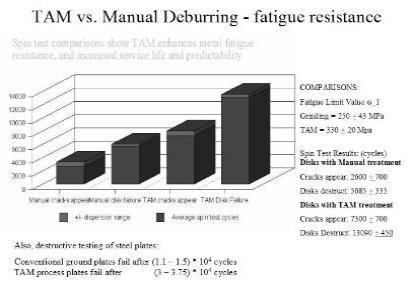
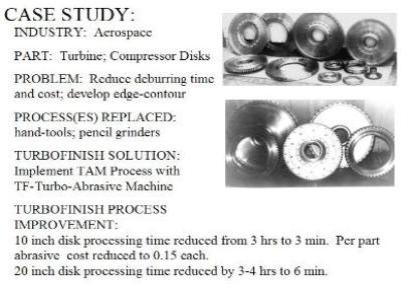
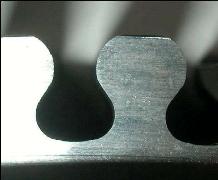
modify sharp edges and
machined or ground surfaces
such as those shown in the
BEFORE close-up photo to the
left to contoured polished edges
and isotropic surfaces shown in
the photo below
